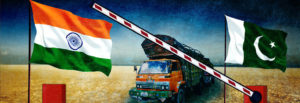Relevance: Mains: G.S paper II: International relations ; G.S paper III: Economy

Why in news?
Foreign Minister Shah Mahmood Qureshi said there can be no normalisation of ties until New Delhi reverses its decision to revoke the special status of Jammu and Kashmir.
CONTEXT
India declined to comment on Pakistan’s flip-flop on plans to go for limited imports of sugar and cotton from the country.
In a volte-face, Pakistan’s Cabinet on Thursday rejected the proposal of a high-powered committee to import cotton and sugar from India.
India-Pakistan trade before ban
Given their tumultuous relationship, trade between the neighbours has always been linked to politics. So, India’s exports to Pakistan fell around 16 per cent to $1.82 billion in 2016-17 from $2.17 billion in 2015-16 after relations deteriorated in the aftermath of the Uri terror attack and the Indian Army’s surgical strikes on militant launchpads in Pakistan-occupied Kashmir in 2016.
Despite continuing tensions, trade between the two countries grew marginally in subsequent years; Indian exports rose nearly 6 per cent to $1.92 billion in 2017-18, and then by around 7 per cent to $2.07 billion in 2018-19. Imports from Pakistan, though much less in volume, also increased by 7.5 per cent to $488.56 million in 2017-18 from $454.49 million in 2016-17.
Growth of imports from Pakistan slowed to around $494.87 million in 2018-19 — an increase of around 1 per cent – before political relations entered a deep freeze in 2019.
Major products traded
- Over the years, India has had a trade surplus with Pakistan, with much less imports than exports. Pakistan was among India’s top 50 trade partners in 2018-19, but was pushed out of the list in 2019-20.
- It had been anticipated that a trade ban between the countries would affect Pakistan more, since it relied heavily on India for key raw materials for its textiles and pharmaceuticals industries.
- In 2018-19, cotton ($550.33 million) and organic chemicals ($457.75 million) accounted for around half of Pakistan’s imports from India.
- Other major Pakistani imports from India that year included plastic ($131.19 million), tanning/dyeing extracts ($114.48 million), and nuclear reactors, boilers, machinery, and mechanical appliances ($94.88 million).
- After the ban, imports of these five products fell drastically to $1 million to $2 million between April 2020 and January 2021, while cotton imports stopped altogether.
- The only increase has been in pharmaceutical products – Pakistan has so far imported around $67.26 million worth of drug products, and over $115 million worth of organic chemicals to ensure sufficient supplies of medicines during the Covid-19 pandemic.
- India’s major imports from Pakistan in 2018-19 were mineral fuels and oils ($131.29 million), edible fruits and nuts ($103.27 million), salt, sulphur, stone and plastering materials ($92.84 million), ores, slag and ash ($17.18 million) and raw hides and leather ($16.27 million).
- The country imported these products in substantially higher volumes from other countries – $25.51 billion worth of mineral fuels and oils from Saudi Arabia; $840.80 million in edible fruits and nuts from the US; $566.52 million in salt, sulphur and plastering materials from the UAE; $862.00 million in ores, slag and ash from Chile; and $83.36 million in raw hides, skin and leather from Italy.

